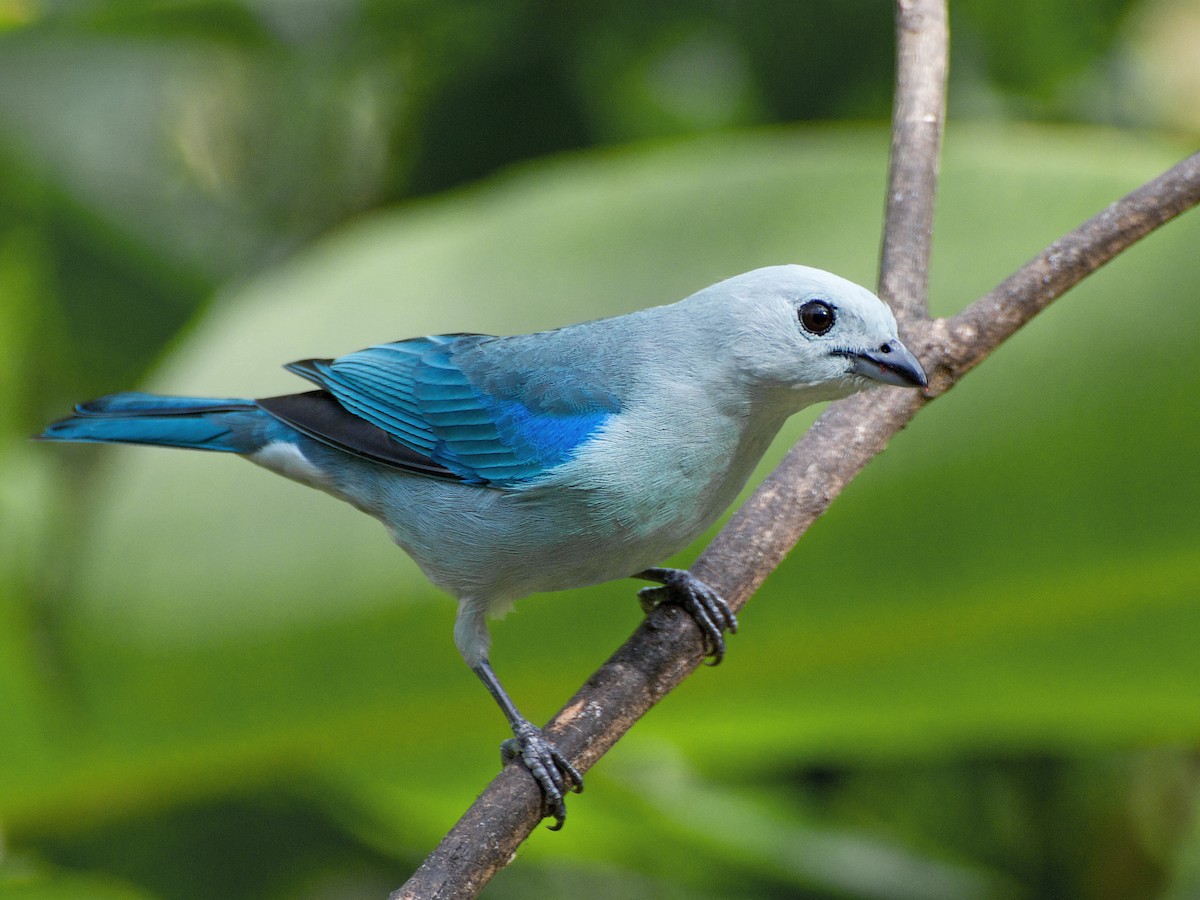When you are around bright, beautiful flower and fruit plants, you are not the only one that feels attracted to them. There are an abundant of butterflies, bees and birds that swarms around these captivating plants buzzing, chirping and singing beautifully. One of these mesmerizing flying creatures is the charming Blue-gray Tanager, commonly known to Guyanese as the Blue Saki. The Blue Saki of Guyana rates very high on the list of seeds dispersal birds primarily due to its diet of mostly fruits.
Features Of The Blue Saki
- Color – Adults have a light bluish head and underparts, with darker blue upperparts and a shoulder patch colored a different hue of blue. The tail and wings are a bright blue and its back is a darker blue. While both sexes are similar in appearance, the color of the female is generally duller and grayer than that of the male. Also, the immature is much duller in plumage, closely resembling the Sayaca Tanager (Thraupis sayaca) of eastern South America.
- Bill – The bill is short and quite thick.
- Weight & Height – The Blue Saki is 16–18 cm (6.3–7.1 in) long and weighs 30–40 g (1.1–1.4 oz).
- Call Notes – The song is a squeaky twittering, interspersed with tseee and tsuup call notes.
Scientific Classification Of The Blue Saki
Blue-gray Tanager (Blue Saki) – Thraupis episcopus [Scientific name]
- Kingdom: Animalia
- Phylum: Chordata
- Class: Aves
- Order: Passeriformes
- Family: Thraupidae
- Genus: Thraupis
- Species: T. episcopus
Tip: The Blue Saki is a bird that can be easily missed due to its striking azure blue appearance blended against the background of blue sky and dazzling sunlight.
Diet & Habitat Of The Blue Saki
The Blue Saki’s primary diet consists of fruits (frugivore). For this reason, they are considered as very effective seed dispersers; however they may also feed on nectar and insects.
The breeding habitat is open woodland, cultivated areas and gardens. This is a common, restless, noisy and confiding species, usually found in pairs, but sometimes small groups. It thrives around human habitation, and will take some cultivated fruit like papayas.
The Blue Saki is a South American (Guyana) songbird. Its range is from Mexico south to northeast Bolivia and northern Brazil, all of the Amazon Basin, except the very south. It has been introduced to Lima (Peru). It can also be found in Trinidad and Tobago where it is called blue jean.
Reproduction Of The Blue Saki
These birds lay some beautiful eggs. Breeding season is from March to July. One to three, usually two, dark-marked whitish to gray-green eggs are laid in a deep cup nest in a high tree fork or building crevice. Incubation by the female is 14 days with another 17 to fledging. Once hatched, both parents feed their chicks. Sadly, the nest is sometimes parasitized by Molothrus cowbirds. Nevertheless, the Blue Sakis continue to be extremely social birds. Pairs remain together year-round and often accompanied by adult offspring, as well as other foraging flocks containing unrelated individuals.
Did You Know?
- The Blue Saki was especially popularized in the 1970’s by Guyanese Legend, Dave Martins who wrote an inspirational song called “Not a blade of grass” during the border conflict with Guyana and Venezuela.
- A beautiful poem was written about the Blue Saki by Dmitri Allicock who was born in Linden, Guyana. The poem is entitled “Beneath the Blue Saki Skies.”
Interesting Facts About The Blue Saki
- Adult Blue Sakis are preyed upon by felines, snakes, birds of prey and crocodilians. Other predators, such as raccoons, eat young birds and eggs.
- Habitat destruction due to deforestation is the primary threat to the Blue Sakis.
- Their maximum lifespan is 9.5 years in the wild.
- They are bred in captivity in large numbers.
- The Blue Saki is one of the most widespread, and ubiquitous, birds of the humid lowland neotropics. It has a stable population of 5,000,000 – 50,000,000 worldwide. They are referred to as ‘common’ due to this large population.
- There are 14 recognized subspecies, differing according to the exact hue of blue of the shoulder patch versus the rest of the plumage; they may be greyish, greenish or purplish-blue, with a lavender, dark blue or whitish shoulder patch.
- They may briefly join mixed-species flocks, but do not travel with such flocks; however, Blue Sakis often join mixed-species aggregations of birds that are attracted to fruiting trees.
Guyana’s Blue Saki
The Blue Saki is indeed a delightful and endearing little bird. Their call notes are very pleasing to the ears and are common to most who are familiar with these birds. Their amazingly, beautiful color is captivating and keeps you looking as they gracefully fly blending in with the blue sky. Because they love fruits so much, they are effective seed dispersers which contributes to the growth of pants in various areas. When it comes to reproduction, they lay some eye-catching eggs and once hatched, both parents care for their young. Indeed, the Blue Saki is a stunning beauty in the country of Guyana.
Article References:
- https://en.wikipedia.org/wiki/Blue-gray_tanager
- https://neotropical.birds.cornell.edu/Species-Account/nb/species/bugtan/overview
- https://www.rainforest-alliance.org/species/tanager
- https://sta.uwi.edu/fst/lifesciences/sites/default/files/lifesciences/documents/ogatt/Thraupis_episcopus%20-%20Blue-grey%20Tanager.pdf
- https://guyaneseonline.net/2013/08/24/the-blue-saki-amazing-seed-disperser-by-dmitri-allicock/
- http://guyana215.blogspot.com/2015/12/blue-saki-thraupis-episcopus.html
- https://ohbeautifulguyana.wordpress.com/2017/10/13/guyana-beneath-the-blue-saki-skies-30-poems-by-dmitri-allicock/
Discover more from Things Guyana
Subscribe to get the latest posts sent to your email.








1 Comment